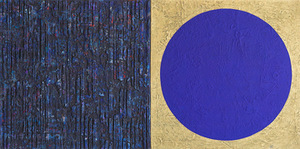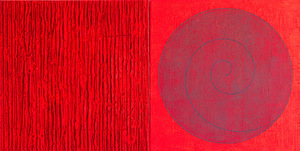Painting limits of Rimas Čiurlionis 3
In brief: Youthful experiences, communication with the Soviet Lithuanian artists, openness to the destinies of the people from DP generation, intellectual Lithuanian-American heritage and the present; western classic art and contemporary art is the basis of the US-based painter Rimas Čiurlionis' oeuvre.
The US-based painter Rimas Čiurlionis grew up in the Soviet Lithuania. He was one of those, who were touched by J. Mikutis' road marks and traces. He communicated directly with Father Stanislovas - at the monk's cell in the church of Paberžė. Conversations of R. Čiurlionis and Father Stanislovas on the topics of art and spiritual metaphysics were followed by the fear of being detected and repressed. They were united by the fact that R. Čiurlionis, at the time, took part in restoring the baroque frescoes of Pažaislis monastery.
R. Čiurlionis immigrated to the United States after the opening of the Iron Curtain, along with many Lithuanians, Central and Eastern European people of that time. Not many emigrants from the former Soviet Union decided to go to America - recently thought of as Eldorado - not to earn more money for better life, house and car, i.e. American life standard, but to continue the artist's career.
Looking at the paintings by R. Čiurlonis is not an exploration of referential, recognizable material reality, a search for familiar signs or a wish to understand how such canvas is born and continues to live. The canvas itself is a thing, beyond which, there are no things. According to the French philosopher Jean Baudrillard, such art would be simulacrum, easily multiplied, generating sings after itself and extending to the black hole of excess signs, which has nothing to do with an individual meaning. R. Čiurlionis' paintings do not have any sings of simulacrum, because it is impossible to reproduce them. The artist's disinterest and light, auto-ironic approach to his paintings does not allow them to be reproduced. Uniqueness overcomes copying.
R. Čiurlionis' works represent a psychological suggestion: abstraction seeks the structure of the state, the prototype of meaning, which echoes religious metaphysics. The artist's works become a framed mirror that does not show the author and the viewers as they were a decade ago, and as a magician he does not charm neither his, nor the audience's future. These mental actions require imagination, which R. Čiurlionis gives meaning to and frames for himself and for the audience. He reaches a psychological-aesthetic contact that stems from the calm eye-sight of R. Čiurlionis, from the dark to the light of quiet coloring.



